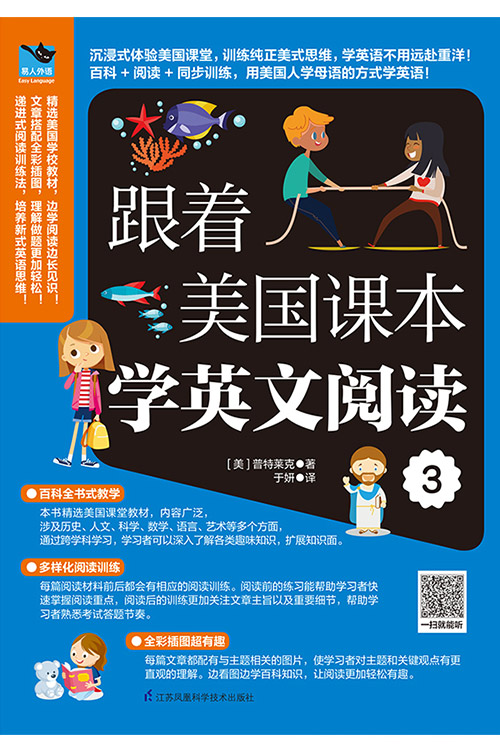定 价:¥45.00
作 者:[美]普特莱克 译者:于妍
出 版 社:江苏凤凰科学技术出版社
出版时间:2018-11-01
ISBN:9787553795737

| 版 次: |
1 |
页 数: |
166 |
字 数: |
|
| 印刷时间: |
2018-11-01 |
开 本: |
16开 |
纸 张: |
轻型纸 |
| 印 次: |
1 |
装 帧: |
平装-胶订 |
正文语种: |
|
编辑推荐:
《跟着美国课本学英文阅读3》编辑推荐:
◆本书精选美国课堂教材,内容广泛,涉及历史、人文、科学等多个方面,让学习者深入了解各类趣味知识,扩展知识面!
◆每篇阅读材料前后都有相应阅读训练,帮助学习者快速掌握阅读重点,更加关注文章主旨以及重要细节,熟悉考试答题节奏!
◆每篇文章都配有与主题相关的图片,使学习者对主题和关键观点有更直观的理解。边看图边学百科知识,让阅读更加轻松有趣!
内容推荐:
本书精选美国课堂教材“社会学科·历史与地理”“科学”“数学”“语言与文学”“观赏艺术”“音乐”中的材料,阅读主题丰富多彩,让英语学习变得更加轻松、有趣。每篇阅读材料都配有大量的练习。除了随堂练习外,还特别设置课后练习、学科综合练习,帮助学习者理解文章主旨,抓住阅读重点,逐步提升阅读能力。词汇是阅读的基础,本书专门制作了单词表,收录阅读中的重要单词,让学习者可以反复学习,直至掌握。本书收录的阅读材料都配有听力,扫描二维码即可收听地道英语,课后练习还专门设置了听写题,让学习者的阅读和听力水平同步提升。
作者简介:
[美] 普特莱克,毕业于美国塔夫茨大学,获得英语文学学士和历史学硕士学位。他撰写的多部英语学习类畅销书被众多学子鼎力推荐。
目录:
Table of Contents
Chapter 1 Social Studies • History and Geography
Unit 01 ………………………………… 7
Early People and Civilizations
Early People
Unit 02 ………………………………… 11
Rivers and Civilizations
The Fertile Crescent and the Kingdoms of Egypt
Unit 03 ………………………………… 15
Asian Civilizations
The Indus Civilization
Unit 04 ………………………………… 19
The Ancient World
Ancient Greece
Unit 05 ………………………………… 23
The Ancient World
The Roman Empire
Unit 06 ………………………………… 27
The Renaissance and the Reformation
From the Middle Ages to the Reformation
Unit 07 ………………………………… 31
The Enlightenment: The Age of Reason
The Enlightenment and the French Revolution
Wrap-Up Test 1 ……………………… 35
Chapter 2 Science
Unit 08 ………………………………… 39
The Characteristics of Living Things
Cells, Reproduction, and Heredity
Unit 09 ………………………………… 43
The Earth’s Oceans
Oceans and Ocean Life
Unit 10 ………………………………… 47
Fossils
What We Can Learn from Fossils
Unit 11 ………………………………… 51
Force and Motion
Newton’s Laws
Unit 12 ………………………………… 55
Light Energy
Light Energy
Unit 13 ………………………………… 59
The Universe
Eclipses
Unit 14 ………………………………… 63
The Human Body
Diseases and the Immune System
Wrap-Up Test 2 ……………………… 67
Chapter 3 Mathematics • Language • Visual Arts • Music
Unit 15 ………………………………… 71
Numbers and Computation
Factors, Prime Numbers, and Exponents
Unit 16 ………………………………… 75
Geometry
Dimensions
Unit 17 ………………………………… 79
Stories, Myths, and Legends
Pygmalion
Unit 18 ………………………………… 83
Grammar and Usage
Sentences
Unit 19 ………………………………… 87
Art Movements
From Baroque Art to Pop Art
Unit 20 ………………………………… 91
The Music of the Middle Ages
Gregorian Chants and
Polyphonic Music
Wrap-Up Test 3 ……………………… 95
• School Textbook 97
• Answers and Translations 139
• Word List 156
媒体评论:
在线试读:
Early People
A couple of million years ago, primitive humans were nothing like the modern humans of today. They were simplistic creatures that shared characteristics with both humans and apes. For much of this time, the Earth was extremely cold. It endured a very long Ice Age. During the Ice Age, much of the Earth’s surface was covered by huge sheets of ice called glaciers. However, around 12,500 years ago, the Ice Age ended. The ice and glaciers receded. And humans began to evolve, to spread out, and to become more civilized.
Archaeologists have created a three-age system to describe prehistoric cultures. They are the Stone Age, the Bronze Age and the Iron Age.
The Stone Age is often divided into the Old Stone Age and the New Stone Age. The Old Stone Age was the first part of the Stone Age and began around 2,000,000 B.C. The New Stone Age was the last part of the Stone Age and began around 10,000 B.C.
During the Old Stone Age, humans lived as hunter-gatherers. They hunted animals and gathered wild plants for food. People could only make simple tools out of stone. Yet people learned how to make fire during this age. Having fire changed humans’ lives a lot. Fire provided light and helped people stay warm. Most of all, people could cook their food. In the New Stone Age, there began to be some more improvements. People learned to farm the land. People also learned to domesticate wild animals such as dogs, sheep, and goats. Some people began to settle in villages where there was fertile soil for farming. Since they could grow their own crops and raise their own animals, they no longer had to live as nomads. However, they still used stone tools, so this time is called the New Stone Age.
Around 3000 B.C., the Bronze Age began in some parts of the world. During it, humans started working with soft metals such as copper and tin. They learned how to create tools and weapons out of bronze. And pottery became more common during this time.
Around 1500 B.C., the Iron Age began in Europe. Of course, it started earlier in some places and later in other places. During the Iron Age, humans began working with iron. Also, the first real cities began to appear, and trade between cities became more commonplace. It was during this age that human civilization started to develop much more quickly than ever before.
书摘与插画:
 吐司三明治自己做最好吃
吐司三明治自己做最好吃 家常肉菜一本就够
家常肉菜一本就够 高血脂就要这样吃
高血脂就要这样吃 大厨教你巧手拌蔬菜沙拉
大厨教你巧手拌蔬菜沙拉 肠胃病就要这样吃
肠胃病就要这样吃 烤箱做家常菜一学就会
烤箱做家常菜一学就会